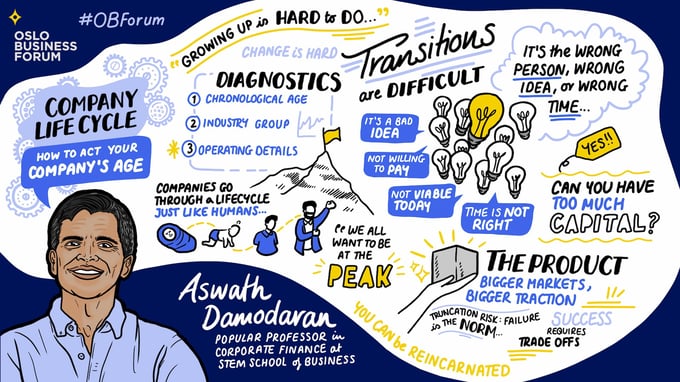At Oslo Business Forum, Aswath set forth the notion that companies go through a life cycle just like humans do. He helped leaders understand how to navigate the sometimes chaotic transitions their businesses face as they move from stage to stage.
The premise of Aswath's Corporate Life Cycle is simple: companies progress through stages much like human beings do.
A startup is like a baby; it needs a lot of care. A very young company is like a toddler; it sometimes stumbles and falls. Aswath refers to the next stage as a corporate teenager; the company has a lot of potential but finds a way to screw it up. In the next stage, a company reaches the peak of its life and its performance. Then it hits middle age, and from there, it declines into old age and, eventually, death.
.jpg?width=680&height=454&name=IMG_8426%20(1).jpg)
Aswath Damodaran is widely known as the finance world's 'Dean of Valuation.' He is a professor of finance at the Stern School of Business at New York University, where he teaches corporate finance and equity valuation. As the author of multiple books on valuation, corporate finance, and investment management, Aswath is regarded as a great teacher and authority.
Aswath shared three simple indicators that business leaders can use to judge where they are in the life cycle, along with the advantages and disadvantages at each stage.
1. Chronological Age. Older companies are more likely to be at mature stages, and younger companies are more likely to be young, growth firms in early stages.
Advantages: Chronological age is easy to measure and intuitive.
Disadvantages: It may not correlate to corporate life cycle age because the latter can vary across sectors, depends on scaling ambitions, and companies can sometimes reinvent themselves.
Aswath used the example of Mattel, a 250-year-old company that is suddenly looking like a young company again after the release of the Barbie movie. Mattel has clearly reinvented and reinvigorated itself.
2. Industry Group. Companies in younger and higher-growth industries are likely to be young and high-growth, as well.
Advantages: Industry group is easy to categorize.
Disadvantages: Companies age at different rates in different industries, depending on the product they produce and their business models.
Aswath used the example of tech companies. Those that emerged during the dot com boom are just approaching middle age, but he describes them as aging in "dog years." Many middle-aged tech companies are showing their age as if they're in later stages of their life cycle.
3. Operating Details. Companies with high revenue growth, negative or low margins and high reinvestment are characterized as young. The opposite is true for mature companies, which are characterized by low revenue growth, high margins, and low reinvestment.
Advantages: Operating details rely on data from a company's history.
Disadvantages: Companies can sometimes be poised to break from the past, in good and bad ways, either for macro or micro reasons.

How To Navigate The Life Cycle
Of course, if you ask a founder or business leader where they would like to be in the corporate life cycle, most would say they want to be at the peak and be there forever. Unfortunately, that's not realistic.
Every company experiences transitions in its life cycle as it moves from one stage to another. Importantly, Aswath pointed out,
"The nature of the chaos you face will be different depending on where you are in the life cycle."
He covered three types of failure that often plague companies and that leaders should watch out for.
1. Idea Failure
For every 100 ideas a business has, they're lucky if five are successful. The things that cause ideas not to reach the product stage include:
- They are not needed: New ideas are built on the assumption that there is an unmet or poorly met need.
- They are not economically valued: Even if a need exists, customers must be willing to pay for the product.
- They are not viable or feasible: Even if a need exists and people will pay, the product or service must be viable or feasible.
- They are not timely: Even if the need exists, customers will pay, and a product is viable, sometimes the time is not right.
2. Founder Failure
Venture capitalists have a list of characteristics that make a successful founder or business leader.
- Characteristics leading to failure: Tunnel vision, arrogance, lack of empathy, savior complex.
- Characteristics leading to success: Discipline, vision, strong communication skills, adaptability.
3. Capital Failure
Converting an idea into a product requires capital. Unfortunately, access to capital varies across time, people, and geographies.
- If access is too difficult, good ideas will never reach the product or business stage.
- If access is too plentiful, some bad ideas with questionable founders can become businesses.
- Ideas requiring more capital fail more often than those requiring less capital intensity.
Aswath pointed out that it is not equally easy to start a business across the world. The largest number of startups are in the U.S. because there is greater access to capital, fewer barriers to entry, and a larger market size.
Success Requires Trade-Offs
Aswath revealed an unfortunate truth to leaders: failure is the norm. According to research, nearly 22 percent of startups fail in their first year, and after 15 years, 75.5 percent of businesses have failed.
So, how do founders and business leaders guard against what appears to be near-certain failure? They make trade-offs.
Purity vs. Pragmatism. Founders who insist on purity of vision and are unwilling to compromise to get to market are more likely to fail.
Growth vs. Business Building. With the limited time and resources they have, founders must decide whether to prioritize growth (scaling up) or building the business.
Small Story vs. Big Story. Early on, founders must determine whether to stay focused on a small and conquerable market or go after a big one. The odds are better for the former, but the pricing is higher for the latter.
Aswath acknowledged one of the most difficult decisions that founders and business leaders must make as they pursue growth: giving up shares and giving up control. "With each round of capital raised, you give up both," he said.
This is commonly referred to as The Founder's Dilemma. Those who give up control end up with higher valuations for their shares of the business than those who hold on to control (CEO and Board).
The Bar Mitzvah Test
When a company is young, investors cut it a lot of slack. They are willing to overlook a young company's financial shortcomings because of its growth potential in large markets. But there will be a time when investors start asking questions about profitability and cash flows and demanding answers about how and when.
"That is the Bar Mitzvah test," Aswath said. "And many young companies are unprepared for it because they never expect to be tested."
One way business leaders can better prepare for the Bar Mitzvah test is to use what Aswath calls the "Build a Business" toolbox. This toolbox encourages leaders to:
Preserve or improve unit economics. Develop and present evidence on unit economics, i.e., profits on the marginal unit sold.
Show evidence of economies of scale. To ensure profitability, a company's revenue should not grow faster than its costs.
Consider trade-offs on growth. Growth is not an unalloyed good; companies should document and show how much it costs to deliver growth.
Should You Scale Up?
"You made it as a business, you passed the Bar Mitzvah test," said Aswath. "Now the question is, should you scale?"
He demonstrated that 34 percent of the share of value creation comes from build-up, and 66 percent comes from scale-up. He explained to leaders that scaling up comes with costs:
Loss of focus. As companies scale up, many will move from their core businesses into new ones.
Less efficient growth. As companies become larger, growth is more difficult to attain and often more expensive to deliver.
Sustainability trade-off. Sustainability and social purpose are the buzzwords of the moment, and every enterprise claims to have these qualities embedded in them. Scaling up often comes at the expense of both, and founders must decide what they value more.
Act Your Age
Aswath reminded leaders that just like many of us, businesses also experience a mid-life crisis. "When you're middle-aged, you get surrounded by an ecosystem of people who try to convince you that you can be young again," Aswath said.
When companies begin to hit barriers, many attempt to fight decline. A common strategy to fight decline is to make business acquisitions. Aswath cautioned against this strategy. "The deals often make things worse," he said.
Aswath closed by offering leaders at Oslo Business Forum some practical advice: "Act your age. Stop trying to be something you're not because, in the process, all you end up doing is throwing away money."
Key Points
- The premise of the Corporate Life Cycle is that companies progress through stages much like human beings do.
- Business leaders can use three indicators to judge where they are in the life cycle: chronological age, industry group, or operating details.
- Every company will experience transitions, and the nature of the chaos it faces will differ depending on where it is in the life cycle.
- Three types of failure often plague companies: product failure, founder failure, and capital failure.
- Guarding against failure requires leaders to make trade-offs, and preparing for growth requires passing the Bar Mitzvah test. They must be prepared to answer investors' questions about profitability and growth.
Questions to Consider
- Where is your company in its life cycle?
- If you're a young company, how can you guard against failure?
- If you're a middle-aged or older company, how can you avoid rapid decline?
- Is your company approaching a life cycle transition? How can you prepare for the next stage?
- Can your company pass the Bar Mitzvah Test? Are you prepared to show investors how you'll achieve profitability and growth?
Want to be a part of the OBF community? Join Oslo Business Forum 2024: Courageous Leadership now!
